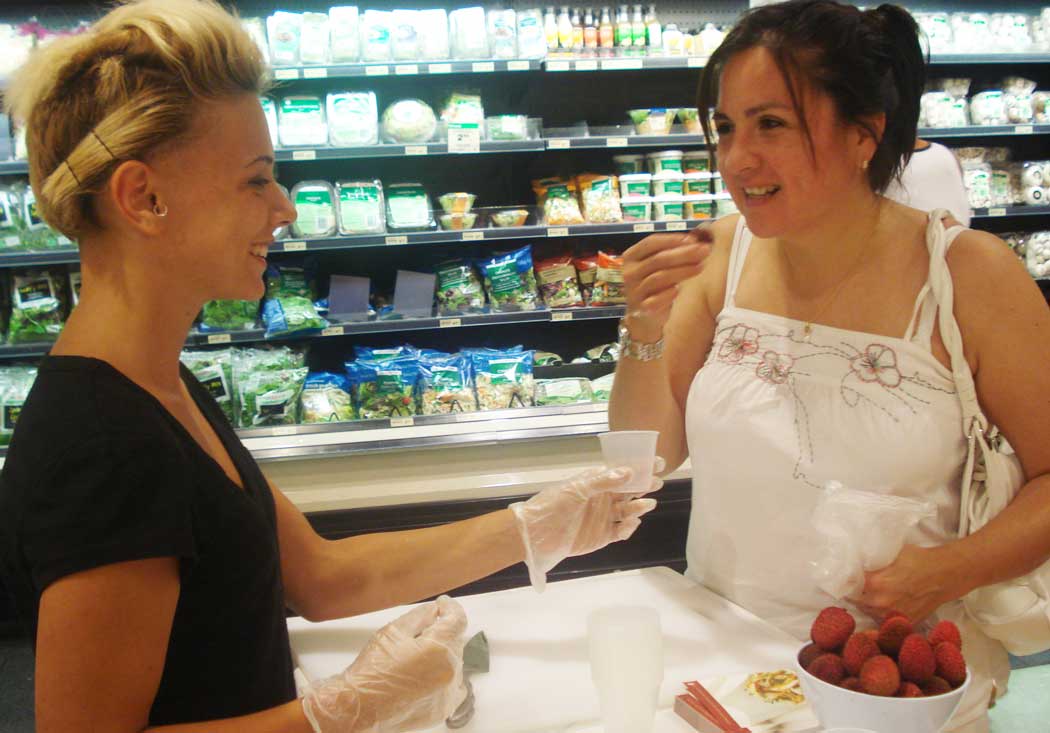Fruit availability
Australian lychees are available from Mid October until March with the season peaking in December and January when lychees are abundantly available.
Selection
Most lychee varieties are ripe when the skin turns pink or red. Once picked, lychees do not continue to ripen.
Choose fruit that is firm and springy, with lush red or pink skin.
Handling and Storage
Storing and handling lychees correctly is the key to increasing sales and offering consumers fruit at its best.
Offer consumers the best quality fruit by following a few simple rules about storage and handling:
- Keep fruit refrigerated at 5°C. To prevent moisture loss, maintain humidity at 90-98%.
- Keep lychees moist by spraying them with water regularly to maintain skin colour.
- Store lychees in plastic packaging, a plastic bag or plastic containers.
- Lychees are best sold fresh within 2 to 3 days of receipt.
- Display fruit in smaller quantities, replenishing only when stock is low to ensure
- customers see lychees at their best.
- Handle lychees with care and do not pile too high to prevent cracking the lychees’ skins.
- Change stock regularly to ensure high quality fruit is always on display.
- Be aware that lychees will discolour in just a couple of hours if left exposed to in-store airconditioning as dehydration turns lychees brown. The fruit may look poor however you can remind consumers of lychees that eating quality is unaffected.
Freshness
It’s no secret Australian lychees are the freshest and best in the world.
Australian growers do not use sulphur dioxide to retain skin colour so Australian lychees are always fresh, sweet, juicy and natural.
Australia has a longer lychee season with fruit available longer than other countries. Early season fruit (from October to December) comes from North Queensland, while fruit available later in the season (January to mid March) comes from South Queensland and Northern New South Wales.
Varieties
While Kwai May Pink makes up 55% of all lychee production, why not introduce customers to other varieties of guilt free, fat free, summer lychee treats?
Kwai May Pink:
- A great eating lychee developed in Australia with a small to medium seed.
- Available from late November to February, they have a red skin with a slight orange hue and tend to be more round.
Fay Zee Siu:
- A large fruit with a sweet taste that is picked with some green mottling on the skin.
- Available from November to December, it is extremely difficult to get commercial crops on a regular basis.
Bengal:
- A classic lychee with a bright red skin and large seed.
- Available from December to January but are in limited supply.
Tai So:
- A pretty red colour when ripe, they are a lovely eating fruit with a similar taste to B3.
- Available from mid November to mid January.
Salathiel:
- Developed in Australia, they are bright red with a smooth skin but are small with a very small seed.
- Available from December to January.
Souey Tung:
- This is the first variety of lychee to be cultivated in Australia. It is becoming more readily available.
- Available from October to November.
Kaimana:
- A relatively new variety that is in limited supply. It is a large red fruit with a small seed.
- Available from November to December.
Sa Keng:
- This is a Thai variety that is a good eating fruit. It is also large and red with a smallish seed.
- Available from December to January.
Healthy treat
Australian lychees are packed full of hidden health and nutrition benefits.
Seven lychees (one serve) contain as much vitamin C as a small orange and provide 100% of the recommended
daily intake of vitamin C.
Lychees are also ranked second behind strawberries in antioxidant levels.
They have fewer than 65 calories per 100g and are fat-free.
Lychees are also medium GI, with a GI level of 57. Their slow releasing energy makes them a great snack to keep you going.
Usage Suggestions
- Peel away the red skin and enjoy lychees fresh.
- Add lychees to a healthy salad.
- Use in marinade and sauces for a summer BBQ.
- Peel and put lychees in a freezer to make a refreshing snack.
- Use them to make a delicious jelly, crumble or cake.
- Muddle together fresh mint with lychees and mineral water for a refreshing summer drink.
Marketing Australian Lychees
The lychee industry is supporting retailers by investing in promoting Australian lychees to drive sales.
At consumer level:
- A marketing and promotion campaign to ensure Australian lychees are included in magazines and newspapers read by your consumers to encourage trial and purchase.
- Developing new recipes and usage suggestions to educate consumers about how to use lychees and encourage consumer trial.
At store level:
- In-store sampling at major supermarkets and green grocers.
- Production and distribution of point-of-sale including recipe cards and educational posters.


